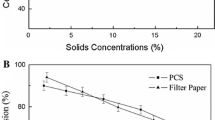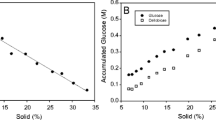Abstract
The concept of reaction severity, which combines residence time and temperature, is often used in the pulp and paper and biorefining industries. The influence of corn stover pretreatment severity on yield of sugar and major degradation products and subsequent effects on enzymatic cellulose hydrolysis was investigated. The pretreatment residence time and temperature, combined into the severity factor (Log R o), were varied with constant acid concentration. With increasing severity, increasing concentrations of furfural and 5-hydroxymethylfurfural (5-HMF) coincided with decreasing yields of oligosaccharides. With further increase in severity factor, the concentrations of furans decreased, while the formation of formic acid and lactic acid increased. For example, from severity 3.87 to 4.32, xylose decreased from 6.39 to 5.26 mg/mL, while furfural increased from 1.04 to 1.33 mg/mL; as the severity was further increased to 4.42, furfural diminished to 1.23 mg/mL as formate rose from 0.62 to 1.83 mg/mL. The effects of dilute acid hydrolyzate, acetic acid, and lignin, in particular, on enzymatic hydrolysis were investigated with a rapid microassay method. The microplate method gave considerable time and cost savings compared to the traditional assay protocol, and it is applicable to a broad range of lignocellulosic substrates.







Similar content being viewed by others
References
Perlack, R. D., et al. (2005). Biomass as feedstock for a bioenergy and bioproducts industry: the technical feasibility of a billion-ton annual supply. US Department of Energy and US department of Agriculture Report.
Xing, R., Subrahmanyam, A. V., Olcay, H., Qi, W., Malone, M. F., van Walsum, G. P., Pendse, H., & Huber, G. W. (2010). Green Chemistry, 12, 1933–1946.
Um, B. H., & Hanley, T. R. (2008). Journal of Microbiology and Biotechnology, 18(7), 1257–1265.
García-Aparicio, M. P., Ballesteros, I., González, A., Oliva, J. M., Ballesteros, M., & Negro, M. J. (2006). Applied Biochemistry and Biotechnology, 129, 278–288.
Yourchisin, D., & van Walsum, G. P. (2004). Applied Biochemistry and Biotechnology, 115(1–3), 1073–1086.
van Walsum, G. P., & Shi, H. (2004). Bioresource Technology, 93(3), 217–226.
Tanaka, M., Ikesaka, M., Matsuno, R., & Converse, A. O. (1998). Biotechnology and Bioengineering, 32(5), 698–706.
Weiss, N. D., Nagle, N. J., Tucker, M. P., & Elander, R. T. (2009). Applied Biochemistry and Biotechnology, 155, 418–428.
Um, B. H., & van Walsum, G. P. (2010). Applied Biochemistry and Biotechnology, 161, 432–447.
Kim, S. B., Um, B. H., & Park, S. C. (2001). Applied Biochemistry and Biotechnology, 91/93, 81–94.
van Walsum, G. P. (2001). Applied Biochemistry and Biotechnology, 91–93, 317–329.
van Walsum, G. P., Allen, S. G., Laser, M. S., Spencer, M. J., Antal, M. J., Jr., & Lynd, L. R. (1996). Applied Biochemistry and Biotechnology, 57/58, 157–170.
Du, B. W., Sharma, L. N., Becker, C., Chen, S. F., Mowery, R. A., van Walsum, G. P., & Chambliss, C. K. (2010). Biotechnology and Bioengineering, 107(3), 430–440.
Um, B. H., & van Walsum, G. P. (2009). Applied Biochemistry and Biotechnology, 153, 127–138.
Chen, S. F., Mowery, R. A., Castleberry, V. A., van Walsum, G. P., & Chambliss, C. K. (2006). Journal of Chromatography A, 1104, 54–61.
Wyman, C. E., Dale, B. E., Elander, R. T., Holtzapple, M., Ladisch, M. R., & Lee, Y. Y. (2005). Bioresource Technology, 96, 1959–1966.
Shevchenko, S. M., Beatson, R. P., & Saddler, J. N. (1999). Applied Biochemistry and Biotechnology, 79, 867–976.
Mosier, N., Wyman, C., Dale, B., Elander, R., Lee, Y. Y., Holtzapple, M., & Ladisch, M. (2005). Bioresource Technology, 96, 673–686.
Ulbricht, R. J., Northup, S. J., & Thomas, J. A. (1984). Fundamental and Applied Toxicology, 4, 843–853.
Jeong, T. S., Um, B. H., Kim, J. S., & Oh, K. K. (2010). Applied Biochemistry and Biotechnology, 161, 22–33.
Tengborg, C., Stenberg, K., Galbe, M., Zacchi, G., Larsson, S., Palmqvist, E., & Hahn-Hägerdal, B. (1998). Applied Biochemistry and Biotechnology, 70–72, 3–15.
Chum, H. L., Johnson, D. K., Black, S. K., & Overend, R. P. (1990). Applied Biochemistry and Biotechnology, 24/25, 1–14.
Sluiter, A., Hames, B., Ruiz, R., Scarlata, C., Sluiter, J., & Tmpleton, D. (2008). Determination of structural carbohydrates and lignin in biomass. National Renewable Energy Laboratory NREL/TP-510-42681 ed. Golden, CO.
Sluiter, A., Hames, B., Ruiz, R., Scarlata, C., Sluiter, J., & Tmpleton, D. (2006). Determination of sugars, byproducts, and degradation products in liquid fraction process samples. National Renewable Energy Laboratory NREL/TP-510-42623 ed. Golden, CO.
Selig, M., Weiss, N., & Ji, Y. (2008). Enzymatic saccharification of lignocellulosic biomass. National Renewable Energy Laboratory NREL/TP-510-42629 ed. Golden, CO.
Acknowledgment
This work was funded by the United States Department of Agriculture (USDA)-USDA-CSREES-NRI, # 2005-35504-16335.
Author information
Authors and Affiliations
Corresponding author
Rights and permissions
About this article
Cite this article
Um, BH., van Walsum, G.P. Effect of Pretreatment Severity on Accumulation of Major Degradation Products from Dilute Acid Pretreated Corn Stover and Subsequent Inhibition of Enzymatic Hydrolysis of Cellulose. Appl Biochem Biotechnol 168, 406–420 (2012). https://doi.org/10.1007/s12010-012-9784-7
Received:
Accepted:
Published:
Issue Date:
DOI: https://doi.org/10.1007/s12010-012-9784-7




